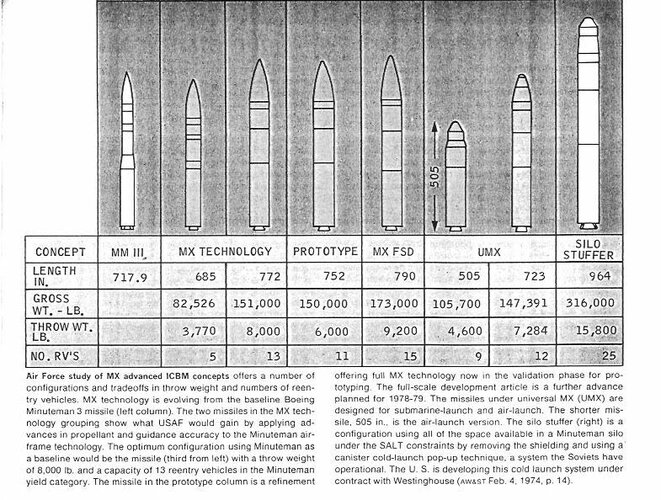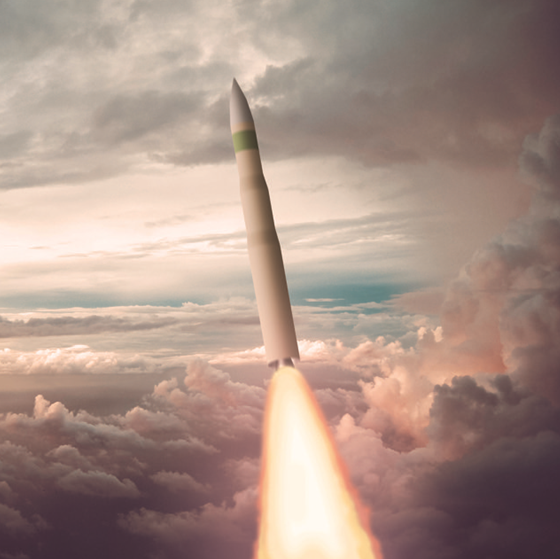Why not just put Peacekeeper back in production?
Because it would take an extra 5-10 years compared to Sentinel? It’s not like any of those components would be available now, so it would be a total redesign.
Why not just put Peacekeeper back in production?
Yes but getting that back then already expensive ICBM Back again will be expensive but im for it. Give it GPS and Astro Navigation and you get pgm ICBM xD
The only way to be relatively secure with road mobile is dirt roads out in the boonies of the western states.
My definition of "relatively secure" for that was "while still obvious to satellites and vulnerable to ballistic/HGV first strike, difficult to attack on the ground."I’d argue modern SAR/EO satellite constellations with AI filtering will make any ground basing without overhead cover insecure by the end of the decade if not before.
They'd need an 85" liner, then.Yes Minuteman silos can take a 120" diameter cold-launched weapon.
Minutemen are already held in a cradle suspended from the sides. You could do something similar (albeit strengthened) for a large cold-launched system.They'd need an 85" liner, then.
Would be a relatively simple swap, then. Trick would be figuring out how flimsy you could make the cold launch tube and still punt the bird clear of the ground before main engine ignition. Though IIRC the existing transporters pull the birds without a liner and would put birds into a liner in the silo.Minutemen are already held in a cradle suspended from the sides. You could do something similar (albeit strengthened) for a large cold-launched system.
You'd probably want some sort of new structure to both support the much heavier missile and canister, not to mention one capable of resisting the force of ejecting the missile.Would be a relatively simple swap, then. Trick would be figuring out how flimsy you could make the cold launch tube and still punt the bird clear of the ground before main engine ignition. Though IIRC the existing transporters pull the birds without a liner and would put birds into a liner in the silo.

I would be very happy to see the Sentinel end up as the Silo Stuffer.You'd probably want some sort of new structure to both support the much heavier missile and canister, not to mention one capable of resisting the force of ejecting the missile.
Somewhat moot, given much of GBSD's cost are to do with rebuilding ICBM force's infrastructure, so you could probably just build new silos, provided they were in already existing missile fields.
Reusing Minuteman silos does offer the potential for much bigger missiles than Trident, see Silo-Stuffer below:
View attachment 711792
My definition of "relatively secure" for that was "while still obvious to satellites and vulnerable to ballistic/HGV first strike, difficult to attack on the ground."
Does the US need a heavy hitting bunker killer ICBM like the old Titans.
The Midgetman TEL wasn't that vulnerable once grounded. That's the setup I would assume for any road-mobile IRBM, especially in a small country.I read that as insecure for all intents and purposes. At least in a silo a nuke would be required; a mobile missile is a soft target once its location is known. A conventional HGV could be used against it, and unless there is enough separation, multiple TELs might be engaged by single nuclear detonation. I’d rather stick to a silo then have to assume at any given moment a number of my ICBM TELs positions (or all of them) were known.
Yes. Something carrying 8-14x 450+kt booms, as long as it's landing within 50m of point of aim. Like Trident II.Does the US need a heavy hitting bunker killer ICBM like the old Titans.
Does the US need a heavy hitting bunker killer ICBM like the old Titans.
The Midgetman TEL wasn't that vulnerable once grounded. That's the setup I would assume for any road-mobile IRBM, especially in a small country.
Oh, there's still a major security element at the silos.It seems like a diminishing return to me. It’s still a relatively soft target and it is limited to a single small RV. If you can’t ensure that the location of your ICBM can be concealed, mobile basing loses all advantage, IMO. The silo requires a nuke and is easy to staff and maintain without a burdensome security element.
Because it may be cheaper than digging more silos, if we get to the point of having all silos filled.SSBNs continue to be the bulk of the warhead count and the primary secondary strike capability, so why invest money in a questionable deployment scheme that will only grow more vulnerability with time?
Oh, there's still a major security element at the silos.
Also, I was assuming a missile with at least 3x MIRVs, not a single warhead. Minuteman or maybe Polaris/Poseidon sized birds, not Midgetman.
Because it may be cheaper than digging more silos, if we get to the point of having all silos filled.
I read an article years ago (that I probably saved somewhere) where the head of StratCom said he’s seen D5 tests where the aim point was often inside the [non-explosive] RV crater. That’s some serious accuracy.Yes. Something carrying 8-14x 450+kt booms, as long as it's landing within 50m of point of aim. Like Trident II.
When the Kentucky (Ohio D5 boat) had visitors onboard, the MTs would tell the visitors to picture their local sportsball field, usually the Kingdome in Seattle. Polaris would land somewhere in the parking lot. Poseidon would land somewhere inside the stadium. Trident 1 would land somewhere on the infield. Trident 2 would land on the pitcher's mound, and you could call which corner of the pitcher's rubber block you wanted.I read an article years ago (that I probably saved somewhere) where the head of StratCom said he’s seen D5 tests where the aim point was often inside the [non-explosive] RV crater. That’s some serious accuracy.
You could have built >300 for the price of 20 B-2s.Expensive. Very expensive
2nd from left is likely to be close to the Sentinel IMO.You'd probably want some sort of new structure to both support the much heavier missile and canister, not to mention one capable of resisting the force of ejecting the missile.
Somewhat moot, given much of GBSD's cost are to do with rebuilding ICBM force's infrastructure, so you could probably just build new silos, provided they were in already existing missile fields.
Reusing Minuteman silos does offer the potential for much bigger missiles than Trident, see Silo-Stuffer below:
View attachment 711792
Isn't the missile 3rd from left shorter than a Peacekeeper (39.384 inches to a metre)?You'd probably want some sort of new structure to both support the much heavier missile and canister, not to mention one capable of resisting the force of ejecting the missile.
Somewhat moot, given much of GBSD's cost are to do with rebuilding ICBM force's infrastructure, so you could probably just build new silos, provided they were in already existing missile fields.
Reusing Minuteman silos does offer the potential for much bigger missiles than Trident, see Silo-Stuffer below:
View attachment 711792
Nope. Sentinel will have three stages of different diameters. Sentinel 3rd stage will likely be of similar diameter to MMIII 1st stage with each of the stages below larger than the one above.2nd from left is likely to be close to the Sentinel IMO.
Yes. All of the missiles shown are shorter than PK with the exception of the Silo Stuffer. PK is a very large missile. There is a great display in front of FE Warren AFB showing Peacekeeper, MMIII and MMI. It really shows off the size of Peacekeeper.Isn't the missile 3rd from left shorter than a Peacekeeper (39.384 inches to a metre)?
Curious because the throw weight of Peacekeeper is only rated at 8,000lbs, same as the missile third from left. Maybe the length is the booster length only??Yes. All of the missiles shown are shorter than PK with the exception of the Silo Stuffer. PK is a very large missile. There is a great display in front of FE Warren AFB showing Peacekeeper, MMIII and MMI. It really shows off the size of Peacekeeper.

Sentinal is almost certainly smaller than MM3. Where did you get the notion that it's smallest stage is the size of the MM3 1st stage?Nope. Sentinel will have three stages of different diameters. Sentinel 3rd stage will likely be of similar diameter to MMIII 1st stage with each of the stages below larger than the one above.
Sentinal is almost certainly smaller than MM3. Where did you get the notion that it's smallest stage is the size of the MM3 1st stage?

stocking stuffer, 'silo stuffer', that is the loudest project name ever exclaimedYou'd probably want some sort of new structure to both support the much heavier missile and canister, not to mention one capable of resisting the force of ejecting the missile.
Somewhat moot, given much of GBSD's cost are to do with rebuilding ICBM force's infrastructure, so you could probably just build new silos, provided they were in already existing missile fields.
Reusing Minuteman silos does offer the potential for much bigger missiles than Trident, see Silo-Stuffer below:
View attachment 711792
There was a Sentinel first stage test don’t believe they said the diameter. But years earlier there was a SRM “technology demonstrator” first stage that, IIRC, was exactly MMIII size.Is there any information about the SRMs that will be used in the Sentinel?
There were a couple of demonstrator programs. One was LCS-1 which was a tech demonstrator using SR-118 (Peacekeeper 1st stage) as the baseline. There was also MCS-III which was a tech demo designed to show technology insertions within the MMIII 3rd stage OML that could be put into production.There was a Sentinel first stage test don’t believe they said the diameter. But years earlier there was a SRM “technology demonstrator” first stage that, IIRC, was exactly MMIII size.
So my speculation has always been Sentinel will be MMIII sized but lighter therefore with a modestly higher payload.
Nothing has been made public regarding SRM physical dimensions. However, the publicly released art for Sentinel is representative of the proposed design.Is there any information about the SRMs that will be used in the Sentinel?
MMIII first stage is 66” diameter, second 52” diameter, third stage 52”There were a couple of demonstrator programs. One was LCS-1 which was a tech demonstrator using SR-118 (Peacekeeper 1st stage) as the baseline. There was also MCS-III which was a tech demo designed to show technology insertions within the MMIII 3rd stage OML that could be put into production.
As I said previously, Sentinel 3rd stage will be roughly the same diameter as MMIII 1st stage. MMIII 1st stage is about 54” in diameter. Sentinel will be intermediate in size between MMIII and Peacekeeper. As to the question of how I know, as I have stated in the past, I work in the industry.
Sentinel will have more throw weight than MMIII.
Also if you want road-mobiles, the best option is to use a harden shell game method, moving the launcher between say 10 hardened shelters.
It may very well be smaller, enough for a single W87 Mod 0/1 and penaids, since just like the Minuteman. The penaids may give it a paper throw weight similar to Minuteman's triple warhead configuration but the warhead will probably be singular. There aren't many W87s left and no real capacity to make more after all!
Even if there's only a limited number of W87s to go around it still makes sense for the Sentinel to be able to carry more than one RV as a way of future-proofing the design.
